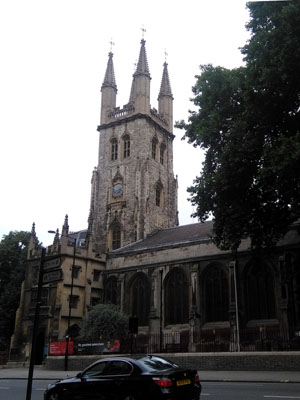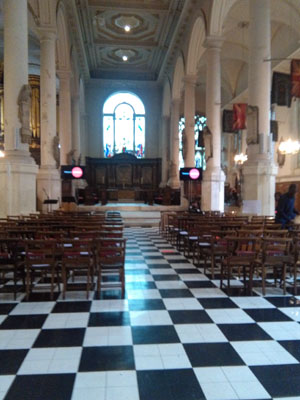| |
 |
 |
 |
| Comment on this report, or find other reports. |
 |
| Our Mystery Worshippers are volunteers who warm church pews for us around the world. If you'd like to become a Mystery Worshipper, start here. |
 |
| Find out how to reproduce this report in your church magazine or website. |
|
|
| 3208: St Sepulchre-without-Newgate, Holborn, London |
 |
 |
 |
Mystery Worshipper: The Citric Ascetic.
The church: St Sepulchre-without-Newgate, Holborn, London.
Denomination: Church of England, Diocese of London.
The building: Like many churches in the City of London, it has undergone various rebuilds since the original Saxon church was built in 1137. These included a complete rebuild in the 15th century after being gutted by the Great Fire of London. Surprisingly, though, it managed to survive the Second World War blitz largely unscathed, save for a watch-house in the churchyard. The current interior dates back to the last major restoration in 1878. The black-and-white tiled floor and tall nave give the place a bit of a "wow" factor as you enter, though on closer inspection one can see parts of the pillars and ceilings that are in need of some repair. The church houses two chapels, one on either side of the nave: the Musicians’ Chapel and the Royal Fusiliers Chapel. In the Musicians’ Chapel are interred the ashes of Sir Henry Wood, the founder of the Proms. Above the Fusiliers chapel are past regimental colours; though they look quite worn and faded, they are saturated in history.
The church: The church’s full name is "St Sepulchre with Christ Church, Greyfriars and St Leonard, Foster Lane." The "without-Newgate" in its shortened form is reference to the church’s location having been just outside the city wall. Though not referred to directly by name, it is the "Old Bailey" mentioned in the nursery rhyme "Oranges and Lemons" – the association being that the central criminal court, known as the Old Bailey, sits on the opposite side of the road from the church. The church bell, known as the Execution Bell, was rung the night before an execution at Newgate Prison, which is where the Old Bailey is now located. In 1555 the vicar, John Rogers, was executed for being a heretic. Today’s congregation is a recent plant by Holy Trinity Brompton, as the church had ceased to meet on Sunday mornings, with services only being revived in 2013. The church also holds two services on a Tuesday: a lunchtime service and evensong.
The neighbourhood: Though it may be the largest parish church in the City of London, one could be forgiven for overlooking it given the sheer enormity of its close neighbour, St Paul’s Cathedral. Holborn, being part of the Square Mile, is notable for the high density of banking and legal firms, with few residential dwellings. Across the road, one can see the old front of Newgate Prison, and behind that the statue of Justice that stands on top of the Old Bailey. This particular statue of Justice does not, as is a common myth, wear a blindfold.
The cast: The service was co-led by the Revd David Ingall, priest in charge, and Tolu, whose surname wasn’t given. The sung worship was led by Elijah Dobner, contemporary worship pastor.
The date & time: Sunday, 23 July 2017, 10.30am.
What was the name of the service?
All age service.
How full was the building?
There was plenty of space to be had, with the chairs only occupying a small part of the church in the centre of the nave. Even then, there were plenty of spare seats. I counted about 30 people present.
Did anyone welcome you personally?
On approach to the church, I noticed a chap outside with his hands in his pockets who seemed to be patrolling. If he was there for welcome, it was actually a little off-putting. I waited until he got talking to some people and snuck into the church behind him. Upon entering, I was offered a cup of coffee, though no one attempted to strike up a conversation.
Was your pew comfortable?
We had small individual wooden seats. They were more comfortable than they looked, but that’s not to say the seating experience was particularly enjoyable.
How would you describe the pre-service
atmosphere?
People tended to stand around at the back of the church and chat. A few small children ran around.
What were the exact opening words of the
service?
The priest in charge, with an ebullient fortissimo, cried out, “Good morning and welcome.”
What books did the congregation use during the
service?
There were no books or leaflets used at all. In the backs of the chairs there was a card advertising the Alpha course and a copy of The Holy Bible, New International Version, but neither was referred to. Any scripture readings, we were asked to listen rather than read along.
What musical instruments were played?
We had two semi-acoustic guitars.
Did anything distract you?
The church building itself was a distraction, particularly the beautiful stained glass windows. I also couldn't help but spend time looking at the flags above the Royal Fusiliers Chapel; though they were badly worn and in many ways quite the worse for wear, one couldn't help but wonder at the history that lay behind each one. The acoustics were rather good too – even though we only had two guitars and a handful of people, the reverberation made the place sound fuller than it was. It made the prospect of a choral service all the more enticing.

Was the worship stiff-upper-lip, happy clappy, or
what?
Being it was an all age service, I was told it was a little different from normal. There was a healthy dose of sung worship, which was very contemporary in style with no sign of any hymns. Unusual for an Anglican church, there was not a single sign of liturgy or vestments; it felt much more like a middle of the road charismatic service than the Church of England. Throughout the service, in place of a sermon, was a dramatisation of the parable of the talents (from Matthew 25), coupled with some exhortations to think about our own talents. We were provided pieces of paper on which to write our talents down, both temporal and spiritual, and to think about what obstacles might stop us from developing those talents. We then took them up and laid them on the altar.
Exactly how long was the sermon?
No sermon.
Which part of the service was like being in
heaven?
For the intercessions, we all went up to the very front of the church and stood around the altar. It was so lovely because the altar rail was open and people were free to come right to the very front of the church. It made it feel very inclusive, with no separation of clergy from laity.
And which part was like being in... er... the other place?
In jumping from the talent as a unit of currency to talent as a kind of ability, it seemed Tolu was taking liberties with the text a little too far for my more orthodox tastes. Some allowance may be given for this being an all age service, but it was far from being theologically watertight.
What happened when you hung around after the service looking lost?
A couple of people came over and said hello. One of them shook my hand seemingly straight after having washed theirs but not dried, so I had to dry my own hand on my trousers. I was able to speak to David briefly, who invited me for a barbecue that many of the church members were going to. However, I had a prior engagement and had to decline.
How would you describe the after-service
coffee?
The coffee was served as we came in. Served in a thick-walled mug, it was really quite tasty. There was also a good selection of biscuits and fresh fruit on offer.
How would you feel about making this church your regular (where 10 = ecstatic, 0 = terminal)?
8 – I’d want to come for a more normal service, but from what I experienced, this was the kind of Anglicanism that appeals to nonconformists.
Did the service make you feel glad to be a
Christian?
Yes.
What one thing will you remember about all this in seven days' time?
The well worn flags, whose muted colours quietly radiated history. |
|
|
 |
 |
 |
| We rely on voluntary donations to stay online. If you're a regular visitor to Ship of Fools, please consider supporting us. |
 |
 |
 |
| The Mystery Pilgrim |
 |
| One of our most seasoned reporters makes the Camino pilgrimage to Santiago de Compostela in Spain. Read here. |
 |
 |
 |
| London churches |
 |
| Read reports from 70 London churches, visited by a small army of Mystery Worshippers on one single Sunday. Read here. |
| |
|
|
|
|


